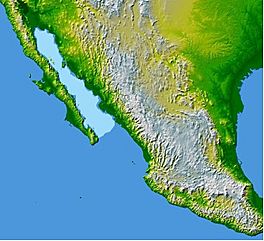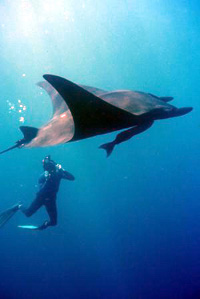Gulf of California facts for kids
Quick facts for kids Gulf of California |
|
|---|---|
| Sea of Cortés, Vermilion Sea | |

Gulf of California (highlighted in light blue)
|
|
| Coordinates | 28°0′N 112°0′W / 28.000°N 112.000°W |
| River sources | Colorado, Fuerte, Mayo, Sinaloa, Sonora, Yaqui |
| Ocean/sea sources | Pacific Ocean |
| Basin countries | Mexico |
| Max. length | 1,126 km (700 mi) |
| Max. width | 48–241 km (30–150 mi) |
| Surface area | 160,000 km2 (62,000 sq mi) |
| Islands | 37 |
| Official name: Islands and Protected Areas of the Gulf of California | |
| Type: | Natural |
| Criteria: | vii, ix, x |
| Designated: | 2005 |
| Reference #: | 1182 |
| Region: | Latin America and the Caribbean |
| Endangered: | 2019–present |
The Gulf of California, also known as the Sea of Cortés or Sea of Cortez, is a large body of water that separates the Baja California peninsula from the main part of Mexico. It is part of the Pacific Ocean. The gulf touches the Mexican states of Baja California, Baja California Sur, Sonora, and Sinaloa. Its coastline is about 4,000 km (2,500 mi) long.
Several rivers flow into the Gulf of California, including the Colorado, Fuerte, Mayo, Sinaloa, Sonora, and Yaqui. The gulf covers an area of about 160,000 km2 (62,000 sq mi). It can be very deep, more than 3,000 meters (9,800 ft) in some places, because of how the Earth's plates have moved over millions of years.
Many scientists believe the Gulf of California is one of the most diverse seas on Earth. It is home to over 5,000 different kinds of tiny sea creatures without backbones. Some parts of the Gulf of California are even recognized as a UNESCO World Heritage Site, which means they are very important to protect.
Geography of the Gulf
How the Gulf was Explored
People have explored the Gulf of California for a long time. Early explorers like Hernán Cortés and Juan Rodríguez Cabrillo sailed its waters. Later, in the 19th century, others like Duflot de Mofras from France and C.H. Gilbert from the United States also visited the area to study it.
Size and Regions
The Gulf of California is about 1,126 km (700 mi) long. It varies in width from 48–241 km (30–150 mi). Its total area is about 177,000 km2 (68,000 sq mi). The average depth is around 818.08 m (2,684.0 ft).
The gulf is divided into three main areas based on the types of animals found there:
- Northern
- Central
- Southern
These areas have different kinds of animals because of differences in water temperature, depth, and other factors.
How the Gulf Formed
Scientists believe the Gulf of California formed about 5.3 million years ago. This happened because huge pieces of the Earth's crust, called tectonic plates, slowly pulled apart. The Baja California peninsula actually split away from the rest of Mexico!
As the plates moved, a crack opened up in the middle of the gulf floor. This crack is an extension of the East Pacific Rise, a place where new ocean crust is being formed. This process still causes volcanic activity, like on Isla Tortuga.
Islands of the Gulf
The Gulf of California has 37 main islands, plus over 900 smaller islets. The two largest islands are Isla Ángel de la Guarda and Isla Tiburón. Most of these islands are found on the western side of the gulf. Many of them were formed by volcanoes erupting a long time ago.
These islands are very important for nature. In 1978, all the islands were made a "Area Reserve and Migratory Bird Refuge and Wildlife" by the Mexican government. Later, in 2000, they became a "flora and fauna protection area." They are also part of a special UNESCO program called "Man and Biosphere," which helps protect important natural places around the world.
Coastlines and Tides
The shores of the Gulf of California come in three main types:
- Rocky shores: These are made of rocks.
- Sandy beaches: These are made of sand.
- Tidal flats: These are muddy or sandy areas that are covered by water at high tide and exposed at low tide.
The type of rock on a shore can affect the animals living there. Shores with softer, more porous rocks often have more different kinds of species. This is because these rocks have more cracks and holes, which make great hiding spots for many animals.
The northern part of the gulf has very big tides, which can rise and fall by as much as 5 m (16 ft).
River Mouths (Estuaries)
An estuary is where a river meets the sea. In the Gulf of California, many estuaries are "negative," meaning the seawater evaporates faster than fresh water flows in. This makes the water saltier than the open ocean.
Historically, the Colorado River Delta was a huge estuary and wetland. However, because of dams and water being used for cities and farms, not much water from the Colorado River reaches the gulf anymore. Even so, the remaining estuaries are still important homes for many types of fish, crabs, and shellfish that people catch for food.
Climate of the Gulf
Air Conditions
While the gulf's shores are usually calm, strong storms called "chubascos" can sometimes hit. Even though they don't last long, they can cause a lot of damage to the coastlines.
Ocean Temperatures
The depth of the water affects its temperature. Shallow areas warm up or cool down quickly with the air, while deeper waters stay more stable. Generally, the water temperature in the gulf ranges from about 16 °C (61 °F) in winter to 24 °C (75 °F) in summer.
However, temperatures can vary a lot. For example, the waters near La Paz can reach 30 °C (86 °F) in August, while nearby Cabo San Lucas only reaches 26 °C (79 °F). Sometimes, in very cold winters, the northern gulf's water can drop below 8 °C (46 °F). This can cause many sea creatures, like algae and plankton, to die off.
| Jan | Feb | Mar | Apr | May | Jun | Jul | Aug | Sep | Oct | Nov | Dec |
|---|---|---|---|---|---|---|---|---|---|---|---|
| 17 °C
63 °F |
16 °C
61 °F |
17 °C
63 °F |
19 °C
66 °F |
21 °C
70 °F |
23 °C
73 °F |
26 °C
79 °F |
28 °C
82 °F |
28 °C
82 °F |
26 °C
79 °F |
23 °C
73 °F |
19 °C
66 °F |
| Jan | Feb | Mar | Apr | May | Jun | Jul | Aug | Sep | Oct | Nov | Dec |
|---|---|---|---|---|---|---|---|---|---|---|---|
| 19 °C
66 °F |
19 °C
66 °F |
21 °C
70 °F |
23 °C
73 °F |
25 °C
77 °F |
27 °C
81 °F |
28 °C
82 °F |
30 °C
85 °F |
28 °C
82 °F |
27 °C
81 °F |
24 °C
75 °F |
21 °C
70 °F |
| Jan | Feb | Mar | Apr | May | Jun | Jul | Aug | Sep | Oct | Nov | Dec |
|---|---|---|---|---|---|---|---|---|---|---|---|
| 20 °C
68 °F |
19 °C
66 °F |
19 °C
66 °F |
19 °C
66 °F |
20 °C
68 °F |
21 °C
70 °F |
24 °C
75 °F |
26 °C
79 °F |
26 °C
79 °F |
26 °C
79 °F |
24 °C
75 °F |
22 °C
72 °F |
Marine Life of the Gulf

The Gulf of California is bursting with amazing sea life! It's home to many unique creatures found nowhere else, like the critically endangered vaquita (a small porpoise). It also hosts many animals that travel long distances, such as:
- Humpback whales
- California gray whales
- Killer whales
- Manta rays
- Humboldt squid
- Leatherback sea turtles
- The world's largest animal, the blue whale
Some whales, like fin whales and sperm whales, live in the gulf all year round and don't migrate. The area near the Colorado River Delta still has a small number of totoaba, a type of fish.
For a long time, the gulf has been a popular spot for sport fishing and commercial fishing. It provides a lot of sardines and anchovies for Mexico.
Protecting Marine Life
The gulf is very important for many marine mammals, especially those that are rare or endangered. Its many islands are crucial nesting sites for thousands of seabirds. The waters are also key places for fish to breed, feed, and raise their young.
Even though the Mexican government has tried to create conservation zones and nature reserves, it's hard to protect such a large area. Overfishing and bottom trawling (a fishing method that drags nets along the seafloor) are big problems. Bottom trawling can destroy important habitats like eelgrass beds.
The communities along the coast, like San Felipe, San Carlos, Cabo San Lucas, and La Paz, depend a lot on fishing and tourism.
In 2019, the Gulf of California was added to the List of World Heritage in Danger. This was because of serious worries about the vaquita, a small porpoise that lives only in the gulf and is very close to disappearing forever.
Water Saltiness (Salinity)
The saltiness of the water, called salinity, is important for marine life. Many sea creatures can only survive within a certain salinity range. The average saltiness of the Gulf of California's surface water is between 3.5% and 3.58%. The northern part of the gulf is generally saltier than the central and southern parts because more water evaporates there.
The "Black Demon" Legend
Some local people have stories about a giant creature called the "Black Demon" (El Demonio Negro) in the Sea of Cortez. It's usually described as a huge black shark, sometimes as big as 20 to 60 ft (6.1 to 18.3 m) and weighing 50,000 to 100,000 lb (23 to 45 t). This legend is similar to other stories of giant sharks in the Pacific Ocean.
See also
 In Spanish: Golfo de California para niños
In Spanish: Golfo de California para niños


